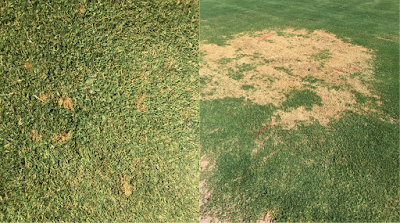 |
Turfgrass infected by Bipolaris sp. - these photos are the same turfgrass
area photographed 10 days apart (Photos: NMSU - PDC) |
Summer rain is a welcome occurrence in the desert, however it can also create a favorable environment for diseases. Recently, conditions have been especially favorable for a few common turfgrass diseases. Leaf spot, melting out and brown patch, have been identified in a
number of samples submitted to the plant clinic over the past several weeks. These
diseases are caused by common soil-borne fungi that are favored by wet, humid
conditions. They can be especially severe when heavy rains follow periods of
drought or dry conditions. Leaf spot and melting-out diseases are caused by a
group of pathogens that used to be grouped together in the fungal genus
Helminthosporium. Two fungi in this group, Bipolaris sp. and Curvularia sp.,
have been isolated from turfgrass samples in New Mexico. Brown patch is caused
by Rhizoctonia solani. Similar environmental conditions favor these diseases
and it is not uncommon to find more than one of these pathogens in the same
sample. When
environmental conditions are highly favorable for disease
development, these diseases can spread rapidly resulting in large areas of
blighted turf.
 |
Curvularia spores
(Photo: NMSU - PDC) |
 |
Leaf spots
caused by
Bipolaris
(Photo: NMSU-PDC) |
 |
Bipolaris spores
(Photo: NMSU - PDC) |
 |
Brown patch caused by Rhizoctonia solani
(Photo: NMSU - PDC) |
 |
Characteristic hyphae of Rhizoctonia
solani (note the right angle branching)
(Photo: NMSU - PDC) |







No comments:
Post a Comment